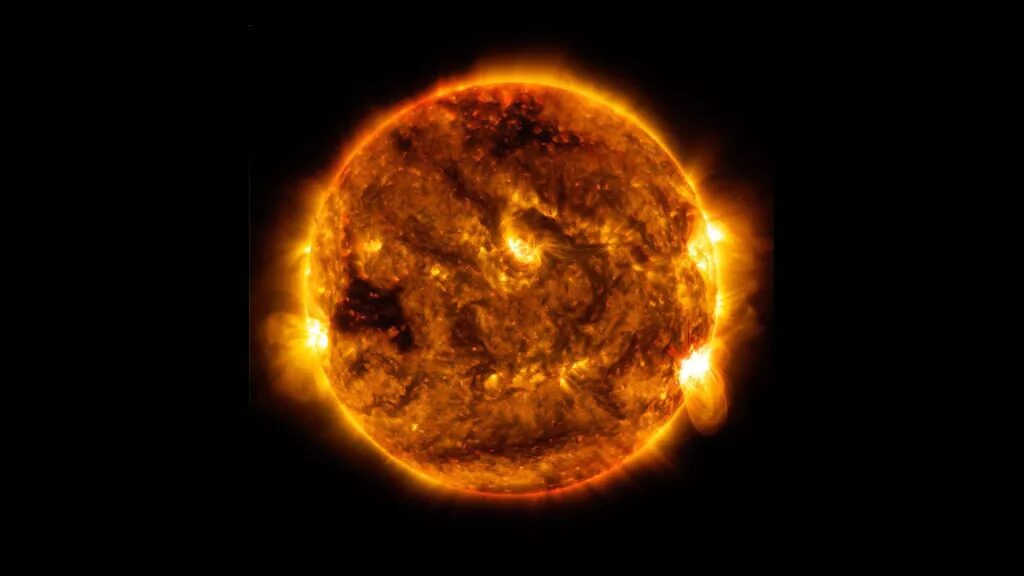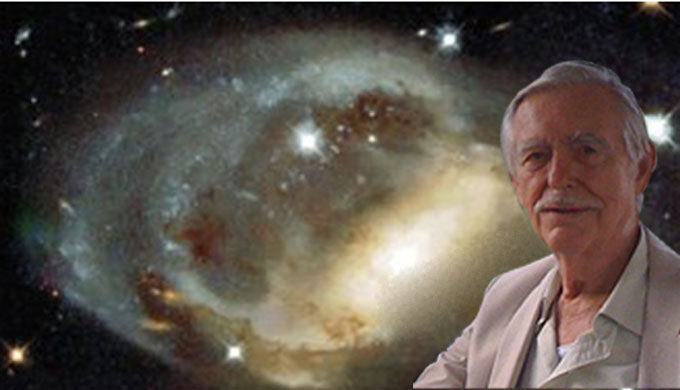One way to accommodate both is to make aliveness into an extra-material property, a spirit that infuses all things. The sun is alive because everything is alive. But to do so is to subtly capitulate to the worldview that holds everything dead, by making aliveness an added property, independent of anything material. It is a version of Cartesian dualism.
Here I will offer another, much more radical alternative. It is an exhilarating alternative. It is a homecoming. It may guide human relations with life generally.
When I say the sun is alive, I don't mean that in the animist sense that everything is alive. If everything is alive, the word alive loses its meaning. We might seek to animate rocks by calling them alive, putting them in the same category as humans, ants, and trees, but we risk by the same token reducing humans, ants, and trees to the status of rocks, comporting with the Newtonian reduction of life to force and mass.
No, I mean the sun is actually alive. That's why I usually refer to it as "Mister Sun." Just kidding. Anthropomorphizing non-human beings is just as much a denial of their beingness as to deny it outright.
I used to think that the sun was only a nuclear furnace, burning up hydrogen by fusing hydrogen nuclei together into other elements (primarily helium) and releasing photons in the process. A furnace is not alive. It doesn't maintain homeostasis. It doesn't respond in complex ways to stimuli. It doesn't evolve over time. It doesn't have organs or other complex structures. It doesn't have a complex metabolism.
In the conventional account of stellar physics, main-sequence stars like the sun are stable because the gas pressure of their plasma equals the inward gravitational pressure generated by their mass. This balance depends on the relative strengths of the various forces of physics. For example, the weak nuclear force launches the proton-proton chain reaction that converts colliding proton pairs into stable deuterium nuclei. If the electromagnetic force were just a bit stronger relative to the strong force, these diprotons would never form. If the weak force were a little stronger, runaway fusion would blow the sun apart in seconds. If it were weaker, the sun would not ignite in the first place.1
Marvelous though it is that the forces of physics are exquisitely calibrated to allow life, there may be something else going on in solar fusion. The sun is extraordinarily complex, with mutually sustaining material and electromagnetic structures. Millions of convection cells, called granulatons, convey plasma to and from deep in the sun's interior. These vast fluxes of plasma generate magnetic fields, which, in complex nonlinear feedback loops, in turn shape the flow of plasma. These interactions influence, and are influenced by, the huge magnetic field generated by the different rotational speed of the sun's core and outer layers.
The complex, dynamic structures of the sun allow matter and energy to move between layers, so that the sun could conceivably adjust the composition of its core to slow or speed the rate of fusion. Not only could this allow it to maintain homeostasis, but also may enable the sun to respond to various stimuli.
Watching this NASA video displaying a computer model of the sun's magnetic field lines, the idea that the sun is alive doesn't seem so far-fetched.
Some scientists even broach the possibility that stars like the sun are not only alive, but also conscious volitional agents. Rupert Sheldrake gives a good overview of the arguments in his 2021 paper, Is the Sun Conscious? According to Sheldrake, the complexity of the sun's electromagnetic structures rival or exceed those of the human brain, a fact of special significance in light of the growing recognition of the role of electromagnetic fields in memory, cognition, and consciousness.
One characteristic of life is volitional movement. Bacteria, animals, fungi, and even plants move in response to their environment, for instance toward food and away from danger. Stars like the sun may do so as well, perhaps through solar flares and coronal mass ejections. Conventional scientific opinion holds the occurrence of such events to be random. But what if they are a means of intentional locomotion, as an octopus's ink jet? According to the physicist Greg Matloff, this provides a possible explanation for various anomalies in stellar motion, the most significant of which is the cohesion of galaxies. Their stars rotate around the galactic core too quickly to be held there by the gravitation of observable matter. In order to preserve the accepted Law of Gravitation, physicists postulate invisible "dark matter" to explain the motions of stars, galaxies, and galaxy clusters.
That makes sense if stars are dead masses subject to gravitation alone. When we observe a flock of birds, we don't assume there must be dark matter holding the flock together by gravitation, because we recognize the birds as volitional agents. Maybe stars are like birds in a flock (or neurons in a brain), sticking together for some purpose we cannot fathom. Matloff and philosopher Clement Vidal claim that stellar locomotion is a testable hypothesis: just observe whether stellar flares are more common or more energetic in the opposite direction of their revolution around the galactic core.
This hypothesis leaves out another important influence: the dynamic, meta-stable electromagnetic structure of galaxies themselves. Once we admit the possibility of living stars, we naturally consider a living galaxy as well. Indeed, at the galactic scale and beyond, vast plasma structures weave the cosmos together, pulling stars and galaxies into their observed configurations. At least that is what an unorthodox lineage of physicists, most notably the Nobel laureate Hannes Alfvén, claim. They theorize that electromagnetism is a primary structuring force of the universe, or even the primary structuring force. Plasma cosmologists use electromagnetism to explain the observed motions of stars and galaxies without recourse to dark matter. Some go further to offer alternative theories of cosmogenesis, stellar and galaxy formation, solar physics, and gravity itself.
While many of these theories are decidedly fringe, the work of Alfvén and his proteges is generally consistent with standard physics, requiring no dramatic revision of its fundamental laws. Why then is it so marginal, even though it offers elegant solutions for problems in cosmology?
I think the answer can be found in a sharp difference in the kind of universe we see when we view it through the perspective of electromagnetism versus gravity. Because of the tight feedback loops between plasma and electromagnetic fields, complex structures can emerge very quickly from initial chaos. Whereas gravity is an attractive force only, electromagnetism is both attractive and repulsive, allowing much more complexity. It forms plasma into cables, filaments, sheaths, pinches, helices, and various composite structures that interact dynamically and connect earth to sun, star to star, and galaxy to galaxy. These autopoetic, lifelike structures are very different from the slow mechanical clumping of matter by gravitation. The view that gives primacy to gravitation sits well at home in the larger paradigm of universe-as-machine, unliving, random, with amino acids as the sole construction set of life and with humans as the sole repositories of intelligence. In contrast, the electric universe perspective, with its tightly coupled feedback loops, emergent structures, and self-modification sits more at home within intuitions of a living universe.
The electromagnetic force is also many orders of magnitude stronger than gravitation and, while it too decreases with the square (electric) or cube (magnetic) of distance, its field is not uniform. The structures that emerge through the electromagnetic force are much harder to simulate via computation, as their nonlinearity makes them exquisitely sensitive to small changes in initial conditions. "The equations of magnetohydrodynamics are notoriously unstable and chaotic," my friend Josh Mitteldorf, who has a Ph.D. in physics, explained. This intractability may be another reason why electromagnetic theories enjoys less favor with most cosmologists.
Like many nonstandard physical theories, the electric universe view attracts many whom the mainstream community would call crackpots. They seek to rewrite basic laws of physics. While I am sympathetic to that endeavor, I am skeptical of any theory that discards accepted physics without accounting for its ability to precisely calculate everything from the properties of the elements to the composition of neutrinos emanating from the sun. Standard physics is immensely successful in this regard. However, in cosmology the dissident physicists in the lineage of Alfvén, Kristian Birkeland, Winston Bostick, and Halton Arp offer plausible alternative explanations for cosmic background radiation, cosmological redshift, quasars, galaxy formation, and other phenomena without discarding Einstein or the quantum mechanics of the 20th century.
Standard cosmology relies heavily on a recessional-velocity-only interpretation of redshift to calculate the distance of celestial objects and the size and age of the universe. A heretical and fractious minority dispute that interpretation, invoking concepts like intrinsic redshift, quantized redshift, and plasma redshift. Mainstream sources say these theories have been "debunked," but as usual, when one delves into the controversy it becomes difficult to tell. One of the most controversial figures is the late Halton Arp, a protege of Edwin Hubble, who was well-respected in the astronomical community until he persisted in opposing the dominant narrative. Eventually his work was, in the opinion of his defenders, unfairly dismissed with shoddy reinterpretations of his data and ad hoc explainings-away of his observations. In the end, he was denied telescope time and shunned by other astronomers. As a result, his ideas remain relatively undeveloped and untested today. Is that because they are not worth testing? Or is it because it would be career madness to do so? It is hard to tell, when the mechanisms of paradigm protection are at work.
What I do know is that alternative cosmological theories, like alternative solar theories, have important implications far beyond their own field. They are wellsprings of different metaphors and intuitions about the nature of reality. Plasma-centric theories obviate the need for a Big Bang, suggesting instead a much more ancient and possibly eternal steady-state universe in which new matter is continuously born. While standard cosmology asserts that entropy is always increasing, plasma-based steady-state theories allow for the ongoing creation of new negentropy (negative entropy, free energy). Whereas standard cosmology posits a universe of basic scarcity, in which we are ever at war against the inevitability of degeneration, and in which the temporary order we call life can exist only by importing energy and exporting entropy, plasma-centric cosmologies posit a universe of fundamental abundance.
Fundamental abundance refers not only to energy and matter, but also to life. The dominant conception of the cosmos holds life to be an exiguous exception to the general rule, existing only as a thin layer of carbon-based biological forms on certain rocky planets under ideal conditions. The modern mind has been mostly blind to the possibility that the defining features of life pervade the universe. Such features become visible through the lens of electromagnetism. The universe as a whole, galaxies, stars, and the earth seem to show key features of life: self-maintenance, physiology, volition,, organs, complex responses to stimuli, homeostasis, self-organization, and in some cases even reproduction. They suggest the animist perspective I began with: that we occupy a living universe.
When we admit that background knowledge, it colors every perception. It suggests we look first for the life of things rather than the mechanism of things. Most importantly, it asks we relate to earth too as alive. I have written elsewhere of the reasons for scientific resistance to that idea (for example, Fear of a Living Planet). The case for a living earth is much more obvious than that for the sun or the cosmos, and, as I argue passionately in Climate — A New Story, crucial to a future worth living in.
Ultimately what is at stake here is the healing of the spirit/matter divide. It is not enough to admit some extra-material quality called life or spirit to animate an otherwise dead world of mathematical forces and masses. That, in fact, maintains the separation. The sun, the earth, the forest, the human being are alive and sacred not because of some extra thing they possess; they are sacred because of what they are. The environmental implications are profound. We stop considering the value of nature, earth, and water in terms merely of their utility. All are alive. Even rocks and metals and clouds, if not alive themselves, are parts of the body of something that is. As are we. We are living parts of the living body of life.
Notes:
1. Actually I am not sure about this. It could be just that the nuclear fuel would be consumed much more quickly and the sun would have burned out before life on earth could get started.
Charles Eisenstein is a writer and a speaker. His four main books are The Ascent of Humanity (2007), Sacred Economics (2011, revised 2020), The More Beautiful World our Hearts Know is Possible (2013) and Climate — A New Story (2018).






Mithraism (Mehr means love or goodness in Parsi) was the ancient religion in Iran, which is the worship of the Sun (Son of god, the giver of life on the planet). The first nation that became Christian (Orthodox) was Armenia. Like most of the mountainous region of Iran, Armenia originally followed Mithraism, The cabal hijacked it, replacing the sun god with a person. So when they say that Jesus is the son of god, they are correct in that sense. This explains all the similarities between Christianity and Mithraism.
Mithraism was on the rise in Rome and something had to be done, since Iranian empire was their arch rival. Mithraism was hijacked and turned into a cult. Members also had to be initiated, swear to secrecy. Sacrificing a bull was part of their ritual. Both were totally the opposite of the original Iranian Mithraism. In Zoroasterian it is Ahriman (Satan) that sacrifices a bull. Saturnalia was turned into Christmas, and a newer version of Christianity, centered in Rome was created.
The flag of Iran had a lion holding a sword with the sun behind it, until the Islamic revolution of 1979. The king's title was 'Aryamehr' (Light of the Aryans) In Middle Iranian languages (Middle Persian, Parthian etc.), miθra became mihr, from which New Persian مهر mehr and Armenian mihr/mehr ultimately derive.
Judaism was turned into something completely different by the Babylonian Jews after their contact with the Iranian Zoroasterians. That's where heaven and hell concept came from.
Mithra (Avestan: Miθra, Old Persian: Miça) commonly known as Mehr, is the Iranian deity of covenant, light, oath, justice and the sun. In addition to being the divinity of contracts, Mithra is also a judicial figure, an all-seeing protector of Truth, and the guardian of cattle, the harvest, and of the Waters.
Etymology
Together with the Vedic common noun mitra, the Avestan common noun miθra derives from Proto-Indo-Iranian *mitrám (Mitra), from the root *mi- "to bind", with the "tool suffix" -tra- "causing to". Thus, etymologically mitra/miθra means "that which causes binding", preserved in the Avestan word for "Covenant, Contract, Oath". In Middle Iranian languages (Middle Persian, Parthian etc.), miθra became mihr, from which New Persian مهر mehr and Armenian mihr/mehr ultimately derive.
in Zoroastrian tradition, Mithra evolved from being an all-seeing figure (hence vaguely associated with the Sun) into a divinity co-identified with the Sun itself, effectively taking over Hvare-khshaeta's ((literally "Radiant Sun") role.